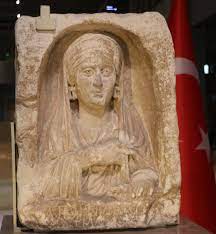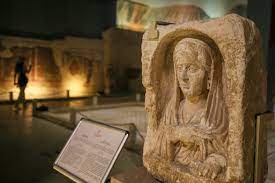Italy repatriates ancient stele from Zeugma to Türkiye

Rome: In a significant development, a centuries-old stele, originating from Zeugma and illegally smuggled out of Türkiye years ago, has been successfully recovered and returned to Türkiye. The ceremonial handover took place at Gaziantep Zeugma Mosaic Museum with the attendance of Culture and Tourism Minister Mehmet Nuri Ersoy.
During the ceremony, Ersoy expressed his gratitude to the Italian authorities for their sensitive approach toward the issue, emphasizing that the unique heritage artifact, engraved with farewell words by a loving Zeugma resident, had finally found its way back to the land where it holds purpose and meaning.
“This truly exceptional heritage asset has returned to the lands where it truly belongs, finding purpose and meaning,” stated Ersoy.
Providing insights into the process of repatriation, Ersoy said: “Allow me to briefly share the details of the repatriation process. This artifact, originating from Zeugma, was seized by Italian authorities in Venice, and they reached out to our ministry for information. Based on the provided details, our ministry promptly conducted a thorough evaluation. Meticulous examinations led by the esteemed Kutalmış Gürkay, the head of the Zeugma excavations, and his team, along with comparative analyses of similar examples, resulted in a definitive conclusion that the artifact indeed originated from Zeugma and was illegally removed from our country.”

“Under the coordination of our anti-smuggling department, various data and samples regarding the artifact’s origin were presented to the Italian authorities, and collaborative efforts were made to reach a resolution. All our evaluations, including relevant information from Türkiye’s legal framework, were incorporated into a comprehensive report. Subsequently, this report was conveyed to the Italian authorities through our Ministry of Foreign Affairs, requesting the return of the tombstone. Following the necessary procedures in Italy, the decision to return the artifact was made, and it was received by our Embassy in Rome,” Ersoy explained.
Elaborating on the history of the tombstone, Ersoy stated: “Zeugma, meaning ‘bridge’ in ancient Greek, witnessed the creation of remarkable works of art throughout its ancient history, particularly during its golden age in the Roman era. It is apparent that this tombstone, which has brought us together today, was erected in this city during the A.D. second century by a devoted Zeugma resident, inscribing words of love and farewell to her husband. The tombstone bears the expressions of a spouse’s love and farewell.”
“Preserving a powerful human story of separation, sorrow and commitment from nearly 2,000 years ago, this artifact transcends time to narrate to us. It has truly returned to the lands where it holds unique heritage, purpose and meaning. At this point, we must underline the significance of Italy, which, like Türkiye, has experienced grievances related to cultural heritage smuggling. The sensitivity they have shown throughout this process deserves utmost appreciation. I extend my sincere gratitude to all relevant officials. I invite all nations and international stakeholders to demonstrate such sensitivity and engage in cooperation when it comes to cultural heritage,” Ersoy remarked.





